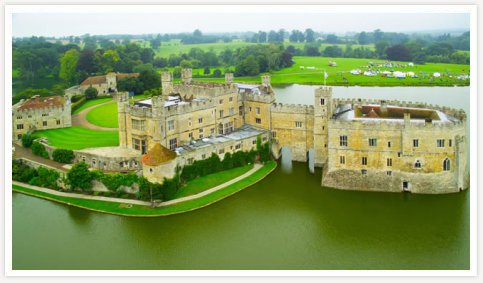Lectures
3rd October 2012: Leeds Castle

The new chairman, David de Saxe, opened the meeting - attended by 71 members - by reminding everyone of the range of activities undertaken by the Society, in addition to facilitating the popular Winter series of lectures.
The speaker, oral historian Dr Ann Kneif, spoke about Leeds Castle; the original section of which, the Gloriat, was built in 1278. It was less of a castle and more of a glorified manor house. Using an aerial photograph of the castle she indicated the various stages of the building over the centuries. The Gloriat almost certainly replaced wooden Anglo-Saxon structures and lies adjacent to the Maiden Tower, built by Henry VIII as a brewery. The Gate Tower, providing the first defence, shows evidence of modification between the thirteenth and the sixteenth centuries. The final phase of construction, this time in the Mock Gothic style, was in 1822 following some considerable demolition.
The land around the castle was already a swamp when the Normans arrived. They built, then created the large moat for defence. One of Dr Kneif's excellent images showed part of the large Norman cellars which gave access to the Great Hall above, evidence of the scale of activity there in the twelfth and thirteenth centuries. The Royal family owned Leeds Castle from the reign of Edward I to Edward VI (the son of Henry VIII) when it became superfluous to Royal requirements. One of the subsequent owners was the famous Fairfax family and the last owner, before transferral to a private trust in 1974, was Lady Baillie. An American heiress, she bought the estate of 3,000 acres with 40 cottages plus the Castle in 1926 for £180,000. She promptly spent a further £100,000 on immediate repairs and in installing electricity, water and central heating with further ongoing renovation maintained throughout her ownership. She had acquired a further 1000 acres during her life there and left only 500 acres to the private trust with the Castle complex, leaving 4000 acres with tenanted farms to her son.
Dr Kneif then gave, in effect, a guided tour of the present castle, sections of which seek to portray selected periods of its past. Much of the décor of the rooms used by Lady Baillie remains in situ though the purpose of some rooms has changed. However, the magnificent library of 3000 books remains.
Averil Clayton
Photograph © http://www.bestourism.com/

